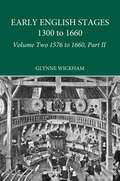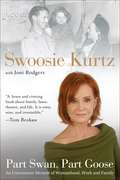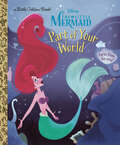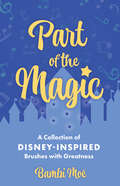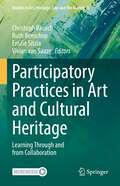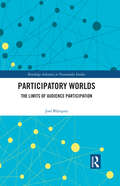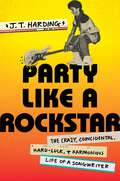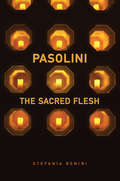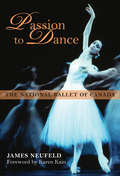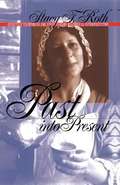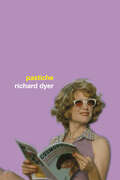- Table View
- List View
Part I - Early English Stages 1576-1600
by Glynne WickhamThis volume forms part of the 5 volume set Early English Stages 1300-1660. This set examines the history of the development of dramatic spectacle and stage convention in England from the beginning of the fourteenth century to 1660.
Part II - Early English Stages 1576-1600
by Glynne WickhamThis volume forms part of the 5 volume set Early English Stages 1300-1660. This set examines the history of the development of dramatic spectacle and stage convention in England from the beginning of the fourteenth century to 1660.
Part Swan, Part Goose: An Uncommon Memoir of Womanhood, Work, and Family
by Joni Rodgers Swoosie KurtzIn a wise, warmhearted memoir that celebrates her extraordinary life and stellar career, Swoosie Kurtz welcomes readers into her world, sharing personal misadventures and showbiz lore and candidly reflecting on the intimate journey of caring for an aging parent. <P><P>Told with intelligence and Swoosie's hallmark comedic timing, Part Swan, Part Goose makes a powerful statement about womanhood, work and family.Swoosie's is the kind of memoir that doesn't come without a fascinating back story: Enter the parents, Frank and Margo Kurtz. Frank, an Olympic diving medalist, later became one of the most decorated aviators in American history. He flew a record number of missions in a cobbled-together B-17D Flying Fortress called "The Swoose," now housed at the National Museum of the U.S. Air Force. Margo chronicled their early years together in her memoir, My Rival, the Sky, published by Putnam in 1945. The book ends with the young couple happily anticipating the birth of a baby to be named after the indomitable Swoose.Today, Margo, who is approaching her hundredth birthday, lives with Swoosie. As Margo's reality drifts freely between her morning coffee and a 1943 war bond tour, Swoosie struggles to stay ahead of her mother's increasing needs while navigating the pitfalls and pratfalls of the entertainment industry. This precarious moment in time is bittersweet and occasionally overwhelming, but every day is oxygenated with laughter and love. The careful weaving of Swoosie's story with passages from My Rival, the Sky creates a vivid portrait of the invincible mother-daughter bond between the two women.Part Swan, Part Goose is that rare Hollywood memoir that takes us behind the curtain but doesn't live there; its heart is solidly at home. It doesn't pretend to tell all, but what it does tell is deeply resonant for millions caring for aging parents, timely and topical for book clubs and entertaining as hell for readers in general.
Part of Your World (Little Golden Book)
by Howard Ashman Alan MenkenSing along to the iconic Disney song "Part of Your World" from The Little Mermaid with this beautifully illustrated Little Golden Book. Perfect for children ages 2 to 5!Dive under the sea and join Disney Princess Ariel as she dreams about what it would be like to join the human world! This beautiful Little Golden Book features the lyrics to the beloved song "Part of Your World" as well as illustrated scenes from the movie and is sure to be a treasure for children ages 2 to 5 as well as Little Golden Book collectors and Disney fans of all ages.Little Golden Books enjoy nearly 100% consumer recognition. They feature beloved classics, hot licenses, and new original stories. . . the classics of tomorrow.
Part of the Magic: A Collection of Disney-Inspired Brushes with Greatness
by Bambi MoéPart of the Magic: A Collection of Disney-Inspired Brushes with Greatness is a book of remarkable and wildly entertaining anecdotal stories told through the lens of an entertainment industry insider. Author Bambi Moé enjoyed a twenty-year career at The Walt Disney Company in charge of all aspects of music for Walt Disney Television Animation. Her name, vocation, and background gave her exceptional access to pop culture and entertainment giants. The book takes readers on a nonstop ride and keeps them riveted throughout extremely candid encounters shared here for the first time. Moé’s fascinating true stories provide a rare insight into the creative process associated with music in animation and give readers a historical reference to The Walt Disney Company’s burgeoning direct-to-video empire. Her career exemplifies the rewards often associated with hard work, perseverance, integrity, and the ability to recognize potential in others. Often the only woman in a male-dominated work environment, Moé’s success will inspire young readers interested in pursuing a career in entertainment. Part of the Magic invites readers to consider their own stories and recognize their own universality. Like a photo that captures life’s moments and teaches us lessons, each of Moé’s brushes with greatness serves as a reminder that we are all connected by reason of our own humanity. Her joy extends far beyond the original encounter and multiplies in the retelling of these stories.
Partial Histories
by Elaine M. McgirrThis book explores the multiple portrayals of the actor and theatre manager Colley Cibber, king of the dunces, professional fop, defacer ofShakespeare and the cruel and unforgiving father of Charlotte Charke. Butthese portraits of Cibber are doubly partial, exposing even as they paper overgaps and biases in the archive while reflecting back modern desires andmethodologies. The Colley Cibber 'everybody knows' has been variouslyconstructed through the rise of English literature as both a culturalenterprise and an academic discipline, a process which made Shakespeare the'nation's poet' and canonised Cibber's enemies Pope and Fielding; theatrehistory's narrative of the birth of naturalism; and the reclamation andcelebration of Charlotte Charke by women's literary history. Each of thesestories requires a Colley Cibber to be its butt, antithesis, and/or bête noir. Thismonograph challenges these partial histories and returns the theatre manager,playwright, poet laureate and bon viveur to the centre of eighteenth-centuryculture and cultural studies.
Participatory Practices in Art and Cultural Heritage: Learning Through and from Collaboration (Studies in Art, Heritage, Law and the Market #5)
by Christoph Rausch Ruth Benschop Emilie Sitzia Vivian Van SaazeThis edited volume analyzes participatory practices in art and cultural heritage in order to determine what can be learned through and from collaboration across disciplinary borders. Following recent developments in museology, museum policies and practices have tended to prioritize community engagement over a traditional focus on collecting and preserving museal objects. At many museal institutions, a shift from a focus on objects to a focus on audiences has taken place. Artistic practices in the visual arts, music, and theater are also increasingly taking on participatory forms. The world of cultural heritage has seen an upsurge in participatory governance models favoring the expertise of local communities over that of trained professionals. While museal institutions, artists, and policy makers consider participation as a tool for implementing diversity policy, a solution to social disjunction, and a form of cultural activism, such participation has also sparked a debate on definitions, and on issues concerning the distribution of authority, power, expertise, agency, and representation. While new forms of audience and community engagement and corresponding models for “co-creation” are flourishing, fundamental but paralyzing critique abounds and the formulation of ethical frameworks and practical guidelines, not to mention theoretical reflection and critical assessment of practices, are lagging.This book offers a space for critically reflecting on participatory practices with the aim of asking and answering the question: How can we learn to better participate? To do so, it focuses on the emergence of new norms and forms of collaboration as participation, and on actual lessons learned from participatory practices. If collaboration is the interdependent formulation of problems and entails the common definition of a shared problem space, how can we best learn to collaborate across disciplinary borders and what exactly can be learned from such collaboration?
Participatory Worlds: The limits of audience participation (Routledge Advances in Transmedia Studies)
by José BlázquezThis book is an in-depth analysis of participatory worlds, practices beyond the mainstream models of content production and IP management that allow audience members to contribute canonically to the expansion of storyworlds, blurring the line between the traditional roles of consumers and producers. Shifting discussions of participatory culture and cross-media production and consumption practices to more independent media contexts, the book explores the limits, borders and boundaries of participating in today’s digital media storyworlds. The text examines how audience participation works, identifying opportunities to make it a meaningful practice for audiences and an asset for IP owners, and discussing the challenges and barriers that the application of participatory culture brings along. The book defines what meaningful participation is by introducing the concept of ‘intervention’ and explains a range of factors impacting the way in which participatory worlds and relationships between producers, audiences and the world are shaped. This volume will be of great relevance to media practitioners, scholars and students interested in transmedia storytelling, fandom, literary studies and comparative literature, new media and digital culture, gaming and media studies.
Partners of the Imagination: The Lives, Art and Struggles of John Arden and Margaretta D’Arcy
by Robert LeachPartners of the Imagination is the first in-depth study of the work of John Arden and Margaretta D’Arcy, partners in writing and cultural and political campaigns. Beginning in the 1950s, Arden and D’Arcy created a series of hugely admired plays performed at Britain’s major theatres. Political activists, they worked tirelessly in the peace movement and the Northern Ireland ‘Troubles’, during which D’Arcy was gaoled. She is also a veteran of the Greenham Common Women’s Peace camp. Their later work included Booker-listed novels, prize-winning stories, essays and radio plays, and D’Arcy founded and ran a Woman’s Pirate Radio station. Raymond Williams described Arden as ‘the most genuinely innovative’ of the playwrights of his generation, and Chambers and Prior claimed that ‘The Non-Stop Connolly Show’, D’Arcy and Arden’s six-play epic, ‘has fair claim to being one of the finest pieces of post-war drama in the English language’. This study explores the connections between art and life, and between the responsibilities of the writer and the citizen. Importantly, it also evaluates the range of literary works (plays, poetry, novels, essays, polemics) created by these writers, both as literature and drama, and as controversialist activity in its own right. This work is a landmark examination of two hugely respected radical writers.
Party Animals
by Kathie Lee GiffordSuccessful talk show host, singer, songwriter, actress, and author Kathie Lee Gifford has come up with a delightful book for children! Lucy Goosy is carefully reviewing her list of animals to invite for her birthday party. She has to make sure to invite the right guests so that her party will be perfect. But when she focuses on everyone’s bad qualities, instead of good, she discovers that there is no one to attend! With a little help from the Wise Owl, Lucy Goosy discovers it is our special characteristics that make us unique. Written in adorable sing-song rhyme, Kathie Lee Gifford’s new picture book for children teaches us that we are all special because we are different! This endearing book comes with a CD, where the accompanying song "Party Animals” is performed by the author so kids can read and sing along with the music.
Party Animals: A Hollywood Tale of Sex, Drugs, and Rock 'n' Roll Starring the Fabulous Allan Carr
by Robert HoflerAllan Carr was Hollywood's premier party-thrower during the town's most hedonistic era--the cocaine-addled, sexually indulgent 1970s. Hosting outrageous soirees with names like the Mick Jagger/Cycle Sluts Party and masterminding such lavishly themed opening nights as the Tommy/New York City subway premiere, it was Carr, an obese, caftan-wearing producer--the ultimate outsider--who first brought movie stars and rock stars, gays and straights, Old and New Hollywood together. From the stunning success of Grease and La Cage aux Folles to the spectacular failure of the Village People's Can't Stop the Music, as a producer Carr's was a rollercoaster of a career punctuated by major hits and phenomenal flops--none more disastrous than the Academy Awards show he produced featuring a tone-deaf Rob Lowe serenading Snow White, a fiasco that made Carr an outcast, and is still widely considered to be the worst Oscars ever. Tracing Carr's excess-laden rise and tragic fall--and sparing no one along the way--Party Animals provides a sizzling, candid, behind-the-scenes look at Hollywood's most infamous period.
Party Like a Rockstar: The Crazy, Coincidental, Hard-Luck, and Harmonious Life of a Songwriter
by J.T. HardingThis fun and fast-paced rock-and-roll memoir from hit singer-songwriter J.T. Harding shows what it takes to go from South Detroit to the top of the Nashville charts.In PARTY LIKE A ROCKSTAR, J.T. Harding charts his life from a kid growing up in Michigan to a chart-topping songwriter living in Nashville and working with country music stars like Keith Urban and Kenny Chesney. As a kid playing rock n' roll in his parents' garage, Harding's was a world in which every taste of new music—from KISS to Prince and everyone in between—was a revelation. Inspired by his favorite artists, Harding abandons the classic "American Dream" and runs away to Los Angeles, where he forms a band and becomes part of the music scene there, all the while selling records to his favorite artists and producers at Tower Records.A story of youth, rebellion, and determination, PARTY LIKE A ROCKSTAR is a memoir for music lovers and an invaluable how-to guide for anyone who wants to learn how to write a hit song. Fun and heartfelt, Harding's memoir is the story of one man's unshakable love for rock and roll, how it guided him through some of the greatest tragedies—and greatest triumphs—of his wild and unvarnished life.
Paso a paso (Fama): Prepárate a fondo para conseguir tu sueño
by González, Lola¿Te gustaría conquistar tu sueño y no sabes por dónde empezar? ¿Fantaseas a menudo con la idea de triunfar sobre los escenarios? ¿Eres fan del programa Fama ¡a bailar! y quisieras seguir el ejemplo de alguno de los concursantes más queridos? Si harías lo que fuera por conseguir tu sueño, descubre que el secreto para alcanzarlo se esconde en tu interior. Abre bien los ojos y aprende paso a paso: - a rentabilizar tus dudas y a conocer tus limitaciones. - a cuidar tu imagen para que sea perfecta en cualquier entrevista o casting. - a valorar la importancia del trabajo y a interiorizar que la pasión y la entrega son los valores necesarios para conseguir el éxito. - a ser autodisciplinado, a escuchar, a preguntar y a trabajar en equipo. Lola González, la directora de la escuela de Fama ¡a bailar!, el programa de superación personal y de baile de más audiencia de la televisión, te ofrece en Paso a paso los mejores consejos y las anécdotas más divertidas de la escuela, y todo lo que ha aprendido como profesional de la danza y como profesora en los últimos años. Un libro divertido en el que encontrarás las herramientas necesarias para hacer realidad tu sueño.
Pasolini
by Stefania BeniniPoet, novelist, dramatist, polemicist, and filmmaker Pier Paolo Pasolini continues to be one of the most influential intellectuals of post-war Italy. In Pasolini: The Sacred Flesh, Stefania Benini examines his corporeal vision of the sacred, focusing on his immanent interpretation of the Christian doctrine of the Incarnation and the "sacred flesh" of Christ in both Passion and Death as the subproletarian flesh of the outcast at the margins of capitalism.By investigating the many crucifixions within Pasolini's poems, novels, films, cinematic scripts and treatments, as well as his subversive hagiographies of criminal or crazed saints, Benini illuminates the radical politics embedded within Pasolini's adoption of Christian themes. Drawing on the work of theorists such as Ernesto De Martino, Mircea Eliade, Jean-Luc Nancy, Alain Badiou, Giorgio Agamben, and Slavoj Žižek, she shows how Pasolini's meditation on the disappearance of the sacred in our times and its return as a haunting revenant, a threatening disruption of capitalist society, foreshadows current debates on the status of the sacred in our postmodern world.
Pasolini Requiem: Second Edition
by Barth David SchwartzPier Paolo Pasolini (1922–75) was one of the most important Italian intellectuals of the post–World War II era. An astonishing polymath—poet, novelist, literary critic, political polemicist, screenwriter, and film director—he exerted profound influence on Italian culture up to his untimely death at the age of fifty-three. This revised edition of what the New York Times Book Review has called “the standard Pasolini biography” introduces the artist to a new generation of readers. Based on extensive interviews with those who knew Pasolini, both friends and enemies, admirers and detractors, Pasolini Requiem chronicles his growth from poet in the provinces to Italy’s leading “civil poet”; his flight to Rome in 1950; the scandalous success of his two novels and political writing; and his transition to film, where he started as a contributor to the golden age of Italian cinema and ended with the shocking Salò, or the 120 Days of Sodom. Pasolini’s tragic and still unsolved murder has remained a subject of contentious debate for four decades. The enduring fascination with who committed the crime—and why—reflects his vital stature in Italy’s political and social history. Updated throughout and with a new afterword covering the efforts to reopen the investigation—and the legal maelstrom surrounding Pasolini’s demise—this edition of Pasolini Requiem is a riveting account of one of the twentieth century’s most controversial, ever-present iconoclasts.
Passion and Pain: The Life of Hector Lavoe
by Marc ShapiroA definitive biography of Hector Lavoe's rise from Puerto Rico to stardom in New York that led to sold-out concerts and best-selling salsa albums, yet gave way to drug addiction, a strained marriage and tragedy.From the poverty-stricken streets of Ponce, Puerto Rico to the vibrant barrios of New York City, HECTOR LAVOE became the singer of all singers, and the driving-force behind the Salsa movement in the mid-1960s. His popularity rivaled that of his contemporaries, Tito Puente, Celia Cruz and Johnny Pacheco.Behind the music, Hector's life was filled with drugs, alcohol and women. An endless stream of tragedy plagued him, including a gun-related accident that killed his son, Hector's ninth floor jump from a hotel window, and his death in 1993 from AIDS. But Hector's pristine voice, one-of-a-kind stage performances, sold-out concerts and bestselling albums were what his fans remember most and what made him an international icon. His music brought joy to legions of people, and it continues today.Marc Shapiro's Passion and Pain is "A no-holds barred biography" (Uptown Magazine) of a fascinating life.
Passion for the Piano
by Judith OringerEvolution of the piano, its manufacturing, care of a piano, piano competitions, the piano in literature and films, and politics and the piano.
Passion to Dance: The National Ballet of Canada
by James NeufeldThis is the story of the National Ballet of Canada – the people, the determination, and how at sixty it is still creating new work while still representing the classics. Passion to Dance is the story of the National Ballet of Canada – the people who dreamt the company into existence, the determination needed to keep it afloat, the bumps on the road to its success, and above all, its passion for dance as a living, evolving art form. From catch-as-catch-can beginnings – borrowed quarters, tiny stages, enormous dreams the National Ballet has emerged as one of North America’s foremost dance troupes. The company at sixty is a company of its time, engaged in creating challenging new work, yet committed to maintaining the classics of the past, favourites like Swan Lake, The Nutcracker,and The Sleeping Beauty. One hundred and fifty photographs from the company’s archives illustrate this definitive history, filled with eyewitness accounts, backstage glimpses, and fascinating detail. This is a record of one of Canada’s boldest cultural experiments, a book to enjoy now and keep forever.
Passionate Detachments: Technologies of Vision and Violence in American Cinema, 1967-1974 (SUNY series, Horizons of Cinema)
by Amy RustPassionate Detachments investigates the rise of graphic violence in American films of the late 1960s and early 1970s and the popular aesthetics and critical responses this violence inspired. Amy Rust examines four technologies adopted by commercial American cinema after the fall of the Hollywood Production Code: multiple-camera montage, squibs (small explosive devices) and artificial blood, freeze-frames, and zooms. Approaching these technologies as figures, as opposed to mere tools, Rust traces the encounters they mediate between perception (what one sees, hears, and feels) and representation (how those sights, sounds, and feelings make meaning). These technologies, she argues, lend shape to film violence while organizing viewers' on- and off-screen relationships to it.The result proves meaningful for an era self-consciously and perilously preoccupied with bloodshed. The post-Code period found Americans across the political spectrum demanding visual—and increasingly violent—demonstrations of presumably "authentic" realities. Corroborating fantasies of authenticity from military to counterculture, these technologies challenge them as well, pointing, however unwittingly, to the violently classed, gendered, and racialized blind spots such fantasies harbor. More broadly, the technologies answer concerns that films control violence too much or too little. Offering neither mere discourse nor mere thrills, they recover sense and sensation for all, not some, or even most, depictions of bloodshed. As figures, the devices also remediate vision and violence for film theory, which exhibits distrust for each in spite of the complexities phenomenology and psychoanalysis have brought to cinematic perception and pleasure.
Passionate Views: Film, Cognition, and Emotion
by Carl Plantinga and Greg M. SmithThe movie theater has always been a place where people come together to share powerful emotional experiences, from the fear generated by horror films and the anxiety induced by thrillers to the laughter elicited by screwball comedies and the tears precipitated by melodramas. Indeed, the dependability of movies to provide such experiences lies at the center of the medium's appeal and power. Yet cinema's ability to influence, even manipulate, the emotions of the spectator is one of the least-explored topics in film theory today.In Passionate Views, thirteen internationally recognized scholars of film studies, philosophy, and psychology explore the emotional appeal of the cinema. Employing a novel cognitive perspective, the volume investigates the relationship between genre and emotion; explores how film narrative, music, and cinematic techniques such as the close-up are used to elicit emotion; and examines the spectator's identification with and response to film characters.An impressive range of films and topics is brought together by Carl Plantinga and Greg M. Smith, including: the success of Stella Dallas and An Affair to Remember as tearjerkers; the power of Night of the Living Dead to inspire fear and disgust; the sublime evoked in The Passion of Joan of Arc, Aguirre, the Wrath of God, and The Children of Paradise; the emotional basis of film comedy as seen in When Harry Met Sally; the use of cinematic cues in Raiders of the Lost Ark and Local Hero to arouse emotions; the relationship between narrative flow and emotion in Once Upon a Time in the West and E.T.; the emotive use of music in The Elephant Man and A Clockwork Orange; Stranger than Paradise's sense of timing; desire and resolution in Casablanca; audience identification with the main characters in Groundhog Day and The Crying Game; portrayal of perversity in The Silence of the Lambs, Flaming Creatures, and Shivers; and empathy elicited through closeups of actors' faces in Yankee Doodle Dandy and Blade Runner.Passionate Views offers a new approach to our understanding of film and will be of interest to anyone fascinated by the emotional power of motion pictures and their relationship to the central concerns of our lives, as well as by the techniques filmmakers use to move an audience.
Passionate Work: Choreographing a Dance Career
by Ruth HorowitzCorps de ballet literally means the "body" of the ballet company, and it refers to the group of dancers who are not principals. Another large group of dancers puts together portfolios of work, often across several dance companies. These categories of dancers typically don't have name recognition and yet comprise the majority of professional dancers today. The ways that they stitch together careers, through dedication, grit, and no small amount of skill – and the reasons they have for doing so without the promise of fame or fortune – are telling of broader trends that shape the precarious labor of professional dance, and creative careers more generally. In Passionate Work, dance hobbyist and sociologist, Ruth Horowitz captures their stories. When creative labor is studied, it is often thought of in opposition to more conventional work, and the primary metric that distinguishes them is passion. Professional creatives are not working in the traditional sense because they are following their passion. By tracing the careers of such dancers, Horowitz troubles the binary understanding of passion and work. A career in dance requires both, and approaching her subjects through this lens allows her to explore their strategies for sustaining passion through the ups and downs of a career. Horowitz explores how dancers evaluate the rewards and challenges of a notoriously underpaid, and uncertain profession. Horowitz considers major dimensions of a career in a performing art, documenting each stage in a dancer's life. Above all, she shines a light on the strategies used to achieve a sense of biographical continuity in a world often marked by discontinuity and rupture.
Passions and Deceptions: The Early Films of Ernst Lubitsch
by Sabine HakeA collaborator with Warner Brothers and Paramount in the early days of sound film, the German film director Ernst Lubitsch (1892-1947) is famous for his sense of ironic detachment and for the eroticism he infused into such comedies as So This Is Paris and Trouble in Paradise. In a general introduction to his silent and early sound films (1914-1932) and in close readings of his comedies, Sabine Hake focuses on the visual strategies Lubitsch used to convey irony and analyzes his contribution to the rise of classical narrative cinema. Exploring Lubitsch's depiction of femininity and the influence of his early German films on his entire career, she argues that his comedies represent an important outlet for dealing with sexual and cultural differences. The readings cover The Oyster Princess, The Doll, The Mountain Cat, Passion, Deception, So This Is Paris, Monte Carlo, and Trouble in Paradise, which are interpreted as part of an underlying process of negotiation between different modes of representation, narration, and spectatorship--a process that comprises the conditions of production in two different national cinemas and the ongoing changes in film technology. Drawing attention to Lubitsch's previously neglected German films, this book presents the years until 1922 as the formative period in his career.
Past Imperfect
by Joan CollinsJoan Collins, star of films and TV, tells the story of her life. She grew up in England, married young, and several times. She had several love affairs, beautiful children, and a life many women would love.
Past into Present: Effective Techniques for First-Person Historical Interpretation
by Stacy F. RothThe portrayal of historical characters through interactive dramatization or role-playing is an effective, albeit controversial, method used to bring history to life at museums, historic sites, and other public venues. Stacy Roth examines the techniques of first-person interpretation to identify those that have been most effective with audiences while allowing interpreters to maintain historical fidelity.
Pastiche
by Richard DyerWriting with his customary wit and style, Richard Dyer argues that while pastiche can be used to describe works which contain montage or collage, it can also be used to describe works which are a kind of imitation of previous works. Investigating a wide range of cultural texts drawn from films, videos, novels, poetry, rap tracks, music and painting, Richard Dyer explores issues of text, genre, and the use of pastiche as a resource within a work. The final chapter draws together the underlying concern of the book with affect and poetics and discusses the politics of pastiche.

